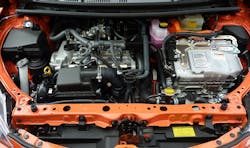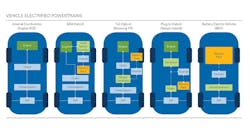Initially, I was ecstatic when automakers started announcing plans for the electrification of their fleets, most with the promise of total completion in 3-5 years. However, excitement quickly faded when I learned that near-term plans are focused on creating various hybrid versions of existing vehicles.
Therefore, new full battery electric vehicles (BEVs) will largely exist at the high end of the market—e.g., the all-electric Jaguar I-PACE: Base MSRP from $69,500, 240-mile range advertised (Jaguar USA, 2018). On the other hand, hybrids will flood the mass market—e.g., the 2018 Ford Fusion Energi: Base MSRP from $33,120, 21-mile all-electric range; and the 2018 Toyota Prius Prime: Base MSRP $27,100, 25-mile all-electric range) (Ayre, 2018)
I’m not excited about hybrids because they are an exercise in design compromise. A hybrid powertrain includes both internal combustion and electric-energy-generation components, which substantially increases vehicle complexity. In addition, many types of hybrid powertrain/drivetrain compositions are being developed concurrently—from mild hybrid to full hybrid to plug-in hybrids—each with multiple variants in terms of electric powertrain integration strategies (Fig. 1).
1. Spectrum of “electrified” hybrid powertrain variants between an internal combustion engine and a battery electric vehicle.
With a hybrid, engineers must still incorporate all the internal-combustion-engine (ICE) components with their corresponding design constraints. Thus, they cannot take full advantage of the design freedoms provided by an all-electric powertrain design. A hybrid vehicle will additionally require more processing power and software control sophistication to manage the dynamic ICE and electric powertrain interfaces.
Tested by Test Needs
During the verification and validation process, the test engineers will deal not only with the electric powertrain AND the ICE powertrain, but with the added complexity of tight integration and interactions between the two systems (Fig. 2). Consider how Subaru tested its ECU to meet thorough test coverage needs for difficult-to-replicate test cases, such as motor runaway due to a loss of traction on icy roads.
The design complexity of integrating two powertrain technologies in one vehicle results in increased testing needs, both in terms of methodology and coverage, which ultimately increases overall test costs. When it comes to design complexity and testing, it’s the worst of both worlds. BEVs have a much simpler powertrain with fewer moving components, less failure points, and lower maintenance costs. Eliminating the ICE components will reduce testing requirements and decrease overall complexity to a level lower than the ICE-only era.
2. Powertrain and test complexity for powertrain designs.
What’s the Holdup with Full BEVs?
Why, then, are automakers not jumping all-in on full BEVs? The technology is superior—simpler powertrains with far fewer components. The environmental implications are obvious—zero emissions. Let’s not forget that instantaneously available full torque from the jump makes them more fun to drive. Eliminating the ICE components allows for so much more design freedom!
The culprits are cost and infrastructure. The additional cost of key attributes such as range and battery-charge time simply aren’t at a level where they are financially viable for the mass-market segment. UBS research estimates that GM loses $7,400 on every mass market targeted Bolt sold.
The financial angle is why automakers with aspirations for all-electric vehicles will target the high end of the market. Show me the money! Conceptually, this will allow them to profitably drive innovation and development on their BEV platforms, which will (hopefully) result in more efficient designs, drive the price of the technology down (currently battery pack costs are estimated to be decreasing at 15% year over year), economies of scale will kick in, and the all-electric vehicle will make as much financial cents as it does technology sense.
As we progress towards that time, governments around the world are implementing regulations for reduced or eliminated emissions, increased fuel economy, and even mandates for prohibiting ICE-only vehicles before full BEVs make mass-market sense. What’s an automotive OEM exec to do? Ah! Hybrids! These will bring increased fuel economy and efficiency, and lower fleet emissions. Unlike the current losses endured on Chevy Bolt and Tesla Model 3 sales, the financials work out on the positive side. And the technology seems like it’ll check all the boxes on the “balanced vehicle design” attribute checklist.
The promise of an “all-electric fleet” really means releasing varying types of hybrid technology and working on a few high-end niche-market all-electric BEVs while waiting for the economics to improve. You can’t blame the automaker executives. Between the intense competitiveness of the market, government mandates, and projections on cost-effectiveness of mass-market EV technology that delivers on key attributes, I’d be making hybrids, too. And that’s why, frustrating as it is for the design and test engineers on the BEV bandwagon, we will have to wade through this hybrid mess before seeing real BEV mass-market adoption.
Better with BEV
Once automakers make the move to full BEVs, they can get rid of all that ICE junk (transmission, belts, the engine). They can shift around the center of gravity by putting the battery pack in the floor. They can evolve structural integrity and rigidity in new and interesting ways. They can give us the fun characteristics of electric-motor powertrains, such as my personal favorite—full torque from standstill. They can put in full braking regen systems and a funky single-pedal design (a colleague said it only took about a week to get used to it in the new 2018 Nissan Leaf…and now he even likes it). The list goes on.
With BEVs, automakers have levers to pull that don’t yet exist, which is why they must make nice with an ICE in the hybrid use case. The design engineers must be looking forward to the death of the hybrid. And the test engineers probably can’t wait either.
BEVs are where it’s at. Let’s get through the hybrid phase as quickly as we can, shall we? Then we can focus on all of the exciting innovations possible with the wondrous all-electric powertrain.
About the Author
Jeff Phillips
Head of Automotive Marketing
As Head of Automotive Marketing at NI, Jeff Phillips is responsible for leading the go-to-market strategy for Automotive initiatives. This involves understanding market needs and expectations, defining solution messaging, and ultimately evangelizing how NI’s software-centric platform can solve the growing challenges in testing the vehicles of today and tomorrow.
Phillips uses his Certified LabVIEW Developer honors to volunteer as a FIRST Robotics mentor with elementary and middle school children and holds a Bachelor’s in mechanical engineering from The University of Tennessee.



